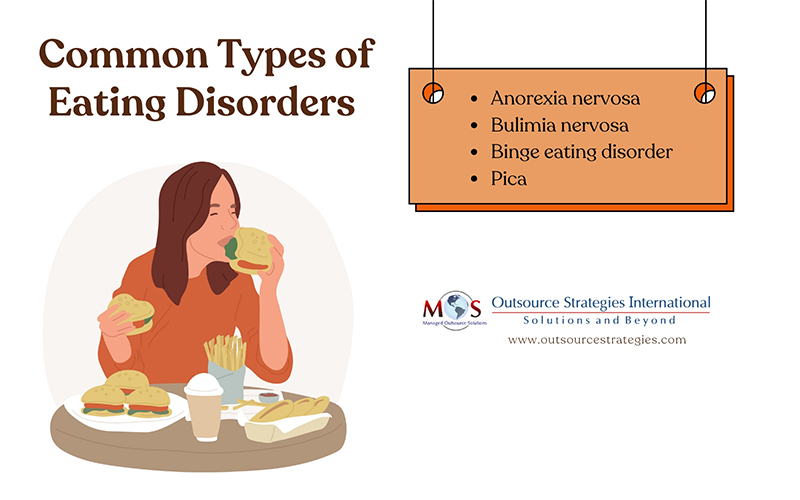Eating disorders are serious mental health conditions that affect eating behaviors and overall well-being. According to the National Association of Anorexia Nervosa and Associated Disorders (ANAD) 28.8 million people in the United States (9% of the population) will have an eating disorder at some point in their lifetime. As these disorders can have severe physical and psychological consequences, they require professional intervention.
Primary care physicians (PCPs) and family physicians play a crucial role in the early detection, diagnosis, and management of eating disorders. Accurate documentation and eating disorder coding compliance are crucial for effective patient care, treatment planning, and reimbursement. However, claim submission for eating disorders can be complex due to factors such as multiple and changing diagnosis codes, prior authorizations, severity levels, etc.
In 2025, there are new ICD-10 codes for eating behavior disorders. The impact of the 2025 ICD-10 updates on eating disorder billing includes changes that may affect code selection, reimbursement rates, and documentation requirements for accurate claims processing. Relying on professional family medicine coding services for primary care providers is a practical way to overcome these challenges and ensure accurate ICD-10 coding to support care and reimbursement.
Ensure accurate coding and maximize reimbursement with expert medical billing and coding services.
This post discusses common eating disorders and their ICD-10 codes for 2025.
Common Eating Disorders and Their Underlying Causes
The most common types of eating disorders are:
- Anorexia nervosa: People with anorexia nervosa often perceive themselves as overweight, even when they are dangerously underweight. They restrict food intake due to an intense fear of gaining weight. According to the National Eating Disorders Association (NEDA) and the National Association of Anorexia Nervosa and Associated Disorders (ANAD), 90-95% of individuals with anorexia nervosa are female, with the condition typically emerging in early to mid-adolescence. It is one of the most common psychiatric diagnoses among girls and women. Anorexia nervosa has the highest mortality rate of any mental health disorder, with estimates suggesting that 5-20% of affected individuals will die due to complications from the illness.
- Bulimia nervosa: This disorder is characterized by repeated cycles of binge eating followed by purging, often accompanied by a loss of control over these episodes. This potentially life-threatening eating disorder can lead to serious health complications, including gastrointestinal issues, severe dehydration, and dangerous electrolyte imbalances. Research suggests that approximately 80% of individuals with bulimia nervosa are female. Unlike some other eating disorders, most people with bulimia maintain an average weight and are often aware that their behaviors are unhealthy.
- Binge eating disorder (BED): This condition is characterized by recurrent episodes of overeating without compensatory behaviors. Individuals with BED often experience a loss of control over their eating habits, which can lead to obesity and an increased risk of developing serious health conditions, such as cardiovascular disease. Both men and women with BED may struggle with intense feelings of guilt, distress, and embarrassment related to their binge-eating episodes, which can further extend the cycle of the disorder and make recovery more challenging.
- Pica: Pica is a compulsive eating disorder characterized by the consumption of non-food items such as clay, ice, dirt, and hairballs, which lack nutritional value. According to the National Institutes of Health (NIH), approximately 32% of children aged 1 to 6 years exhibit this behavior. While pica is more common in young children, it can also occur in pregnant women and individuals with certain medical or psychological conditions.

Other types include avoidant/restrictive food intake disorder (ARFID), which is marked by an aversion to certain foods, and pica, where individuals consume non-food substances.
Eating disorders often arise from a complex interplay of biological, genetic, and environmental factors, sometimes triggered by a specific life event. Individuals with an eating disorder may not exhibit all major symptoms at once, and the signs can vary widely depending on the specific condition. Recognizing these differences is essential, as timely intervention can prevent severe physical and psychological consequences.
Warning signs that may indicate an eating disorder include:
- Chronic dieting (despite being hazardously underweight)
- Constant weight fluctuations
- Obsession with calories and fat contents of food
- Adopting an overly restrictive vegetarian diet
- Excessive focus on healthy eating
- Excessive exercise
- Switching between periods of overeating and fasting
Early detection of symptoms significantly improves the chances of recovery, making awareness of warning signs crucial.
ICD-10 Codes for Eating Disorders in 2025
In ICD-10, eating disorders are list under “Mental, Behavioral, and Neurodevelopmental Disorders” (Chapter 5). The ICD-10 2025 updates introduced new severity-based codes for eating disorders like anorexia, bulimia, and binge eating. These codes provide greater specificity in diagnosing eating disorders, allowing providers to track and document the severity of these conditions more accurately. The new ICD-10 codes for eating disorders are:
F50.010 Anorexia nervosa, restricting type, mild
F50.023 Anorexia nervosa, binge eating/purging type, extreme
F50.21 Bulimia nervosa, mild
F50.814 Binge eating disorder, in remission
F50.83 Pica in adults
F50.84 Rumination disorder in adults
General codes for bulimia and binge eating disorders are now deleted. The full ICD-10 code list for eating disorders beginning October 1, 2024 is as follows:
Anorexia nervosa
F50.010 …… mild
F50.011 …… moderate
F50.012 …… severe
F50.013 …… extreme
F50.014 …… in remission (for both partial and full remission)
F50.019 …… unspecified
The new code F50.010 is used to report mild restricting-type anorexia nervosa, characterized by the absence of binge eating or purging behaviors. This distinction is vital for developing personalized treatment plans and accurately tracking disease progression or remission.
Anorexia nervosa, binge eating/purging type
F50.020 …… mild
F50.021 …… moderate
F50.022 …… severe
F50.023 …… extreme
F50.024 …… in remission (for both partial and full remission)
F50.029 …… unspecified
New code F50.023 represents a severe form of anorexia nervosa, characterized by binge eating and purging behaviors such as self-induced vomiting or laxative misuse. Identifying this high severity level is crucial for ensuring immediate and intensive treatment interventions, emphasizing the urgency of the condition.
F50.2 Bulimia nervosa
F50.20 …… unspecified
F50.21 …… mild
F50.22 …… moderate
F50.23 …… severe
F50.24 …… extreme
F50.25 …… in remission (for partial and full remission)
The addition of a ‘mild’ category for bulimia nervosa (F50.21) enables clinicians and coders to accurately document cases that, while serious, do not meet the criteria for more severe forms. This update helps in monitoring treatment progress and improving care plans.
F50.8 Other eating disorders
F50.81 Binge eating disorder
F50.810 …… mild
F50.811 …… moderate
F50.812 …… severe
F50.813 …… extreme
F50.814 …… in remission (for partial and full remission)
F50.819 …… unspecified
Earlier, binge eating disorder in remission lacked a distinct coding option. The introduction of F50.814 enhances patient management by enabling more precise tracking of recovery. This addition also supports ongoing care and intervention strategies, helping to prevent relapse and promote long-term well-being.
F50.82 Avoidant/restrictive food intake disorder
F50.83 Pica in adults
F50.84 Rumination disorder in adults
F50.89 Other specified eating disorder
F50.9 Eating disorder, unspecified
Pica, a compulsive eating disorder involving non-food items, now has a dedicated ICD-10 code for adults (F50.83), recognizing the need for distinct treatment approaches separate from pediatric cases.
Similarly, rumination disorder in adults has been assigned its own code (F50.84), acknowledging the unique clinical presentation and management requirements of the condition in older patients.
Ensuring Accurate Coding for Comprehensive Eating Disorder Care
The DSM-5 criteria for eating disorders provide standardized guidelines that help clinicians diagnose conditions like anorexia nervosa, bulimia nervosa, and binge-eating disorder accurately for effective treatment and proper medical coding. ICD-10 coding for eating disorders and insurance claims requires thorough and specific documentation to ensure accurate coding, billing, and appropriate insurance reimbursement. The latest ICD-10 code updates highlight the complexity of eating disorders, recognizing that they go beyond food intake restrictions to include psychological, behavioral, and medical aspects. Accurate coding of the severity, type, and progression of these disorders is crucial for effective treatment planning and monitoring. Partnering with a healthcare billing company ensures that certified coders accurately capture a patient’s unique medical profile, supporting proper insurance coverage and optimal reimbursement.
Struggling with complex ICD-10 updates?
Let our certified coders handle it for you.




